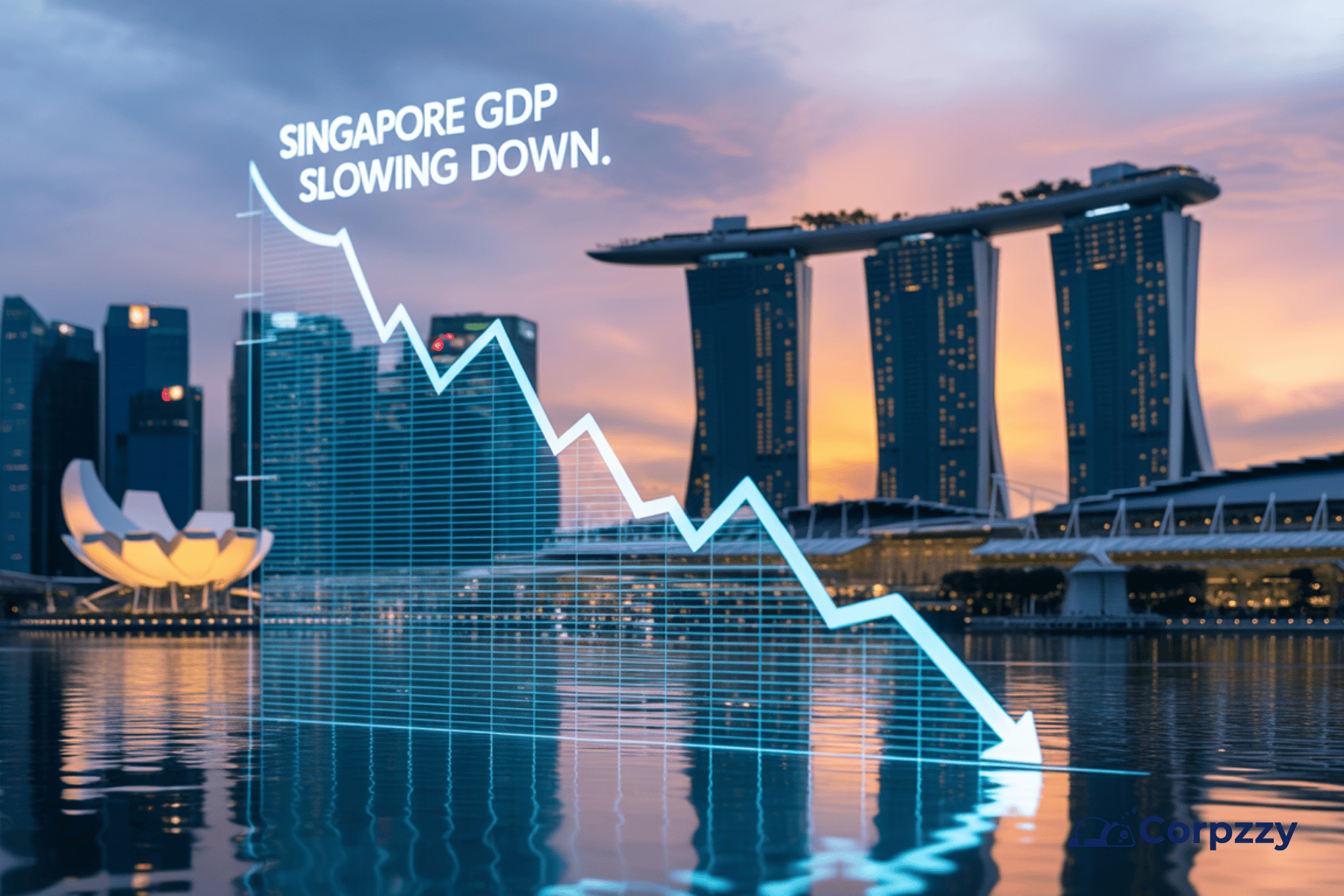Singapore’s Slowing GDP: What Business Owners Should Know in 2025
Singapore’s Slowing GDP: What Business Owners Should Know in 2025
Outline

Singapore’s GDP growth has been revised downward to around 1.6% for 2025, reflecting weakened global demand, the impact of U.S. tariffs, and ongoing challenges in manufacturing. While the lower outlook signals caution, it also opens space for strategic recalibration by business owners, particularly those in export-driven sectors. In this guide, we’ll explore what this means for your business, which industries are most affected, and how to tap into Singapore’s robust support ecosystem to stay resilient.
Key Takeaways
- Singapore offers the most business-friendly environment with a flat 17% corporate tax, high ease of incorporation, and robust startup incentives like EDG and PSG—making it the top choice for entrepreneurs looking to scale efficiently.
- Malaysia remains attractive for cost-conscious businesses, but its higher 24% corporate tax and moderate infrastructure may limit long-term growth potential for tech and innovation-driven ventures.
- Hong Kong rivals Singapore on infrastructure and tax competitiveness, but offers fewer government-led startup grants, making it more suitable for established players than early-stage startups.
- Vietnam presents growing opportunities in export manufacturing, yet its developing infrastructure and maturing regulatory environment may require more groundwork and local partnerships.
- For regional expansion, Singapore remains the ideal HQ base due to its strategic location, policy support, and connectivity to ASEAN markets.
Industries Most Affected by the Slowdown
Export-Oriented Manufacturing
Singapore’s electronics and semiconductor exports have taken a hit due to slower global demand. In May 2025, non-oil domestic exports fell 3.5%, and output from electronics dropped 6.4%.
Why it matters:
- These industries are highly exposed to global trade shifts.
- U.S. tariffs are directly affecting shipment volumes and pricing margins.
- Biomedical manufacturing also declined 14.3%—a sharp correction from pandemic highs.
What you can do:
- Diversify into ASEAN markets less affected by tariffs.
- Automate processes to reduce dependency on global supply chain volatility.
Logistics and Trade Services
Singapore’s trade volume regularly exceeds GDP multiples. A slowdown in trade flow translates into weaker demand for freight forwarding, warehousing, and last-mile logistics.
Why it matters:
- Higher shipping costs and longer lead times affect profit margins.
- Warehousing capacity may outpace utilization as demand softens.
Strategies to adapt:
- Focus on intra-Asia trade logistics.
- Consider digital freight platforms to optimize routing and reduce dead mileage.
Financial and Professional Services
Weak consumer confidence and conservative investor behaviour are slowing deal flows and corporate finance transactions.
Key signals:
- Reduced appetite for M&A and venture capital.
- Professional services like auditing, compliance, and legal remain in demand—especially for firms undergoing restructuring.
Action steps:
- Shift service offerings to include regulatory advisory and business continuity planning.
- Target SMEs and startups seeking affordable compliance packages.
Retail and F&B
Discretionary spending is tightening, affecting lifestyle brands, F&B chains, and experiential retail.
Pain points:
- Apparel and luxury segments are seeing slower foot traffic.
- Food service operators face higher import costs and thinning margins.
What works:
- Pivot to delivery-first models.
- Introduce value-tier offerings and loyalty programs to retain customer base.
Government Support for Businesses in 2025
Despite the slowdown, Singapore offers one of the most comprehensive ecosystems for business support in Asia. Here are key government-backed schemes to help cushion against macroeconomic stress.
| Grant / Initiative | Purpose | Support Level |
|---|---|---|
| Productivity Solutions Grant (PSG) | Subsidises IT solutions and equipment to improve business productivity | Up to 70% funding |
| Enterprise Development Grant (EDG) | Supports business transformation and innovation projects | Up to 50% for SMEs |
| Temporary Bridging Loan Programme (TBLP) | Provides working capital loans with government risk-sharing | Loan up to S$5M, interest rate capped |
| Startup SG Founder Grant | Funding and mentoring support for first-time entrepreneurs | Up to S$50,000 funding + mentorship |
| SkillsFuture Enterprise Credit (SFEC) | Encourages employer investment in upskilling workforce | Subsidy up to S$10,000 per firm |
Comparative Advantage: Singapore vs Regional Competitors
| Location | Corporate Tax Rate | Ease of Incorporation | Startup Incentives | Infrastructure |
|---|---|---|---|---|
| Singapore | 17% flat | Very high | Strong (EDG, PSG) | Excellent |
| Malaysia | 24% | Moderate | Sector-specific | Moderate |
| Hong Kong | 16.5% | High | Some incentives | Excellent |
| Vietnam | 20% | Improving | Export-focused | Developing |
What Entrepreneurs Can Do Right Now
If you’re currently operating a business or planning to start one in Singapore, here are some practical moves:
- Diversify Revenue Streams: Don’t rely solely on U.S.-linked trade. ASEAN and intra-Asia opportunities are growing, especially in tech, services, and green industries.
- Reassess Cost Structure: Review fixed and variable costs. Use government grants to digitize operations and reduce labor dependency.
- Focus on Cash Flow: Tap into schemes like the Temporary Bridging Loan to secure liquidity buffers. Strong cash flow is key to weathering slow quarters.
- Explore Emerging Sectors
- Singapore is doubling down on:
- Fintech & Web3
- Healthtech & Medtech
- AI & Robotics
- Sustainability and Clean Energy
- Singapore is doubling down on:
If your business aligns with these, you’ll likely find incentives, mentorship, and partnerships.
Final Thoughts
Singapore’s trimmed growth projection is not a red flag—it’s a reminder to adapt. The businesses that will thrive are not necessarily the biggest, but the most agile. As the economy recalibrates, a strategic shift in planning, financing, and market focus can position you to grow stronger through 2025 and beyond.
Whether you’re an expat entrepreneur, SME owner, or startup founder, Singapore still offers a robust springboard for regional and global success.
Related Business Articles
Share This Story, Choose Your Platform!


Singapore’s GDP growth has been revised downward to around 1.6% for 2025, reflecting weakened global demand, the impact of U.S. tariffs, and ongoing challenges in manufacturing. While the lower outlook signals caution, it also opens space for strategic recalibration by business owners, particularly those in export-driven sectors. In this guide, we’ll explore what this means for your business, which industries are most affected, and how to tap into Singapore’s robust support ecosystem to stay resilient.
Key Takeaways
- Singapore offers the most business-friendly environment with a flat 17% corporate tax, high ease of incorporation, and robust startup incentives like EDG and PSG—making it the top choice for entrepreneurs looking to scale efficiently.
- Malaysia remains attractive for cost-conscious businesses, but its higher 24% corporate tax and moderate infrastructure may limit long-term growth potential for tech and innovation-driven ventures.
- Hong Kong rivals Singapore on infrastructure and tax competitiveness, but offers fewer government-led startup grants, making it more suitable for established players than early-stage startups.
- Vietnam presents growing opportunities in export manufacturing, yet its developing infrastructure and maturing regulatory environment may require more groundwork and local partnerships.
- For regional expansion, Singapore remains the ideal HQ base due to its strategic location, policy support, and connectivity to ASEAN markets.
Industries Most Affected by the Slowdown
Export-Oriented Manufacturing
Singapore’s electronics and semiconductor exports have taken a hit due to slower global demand. In May 2025, non-oil domestic exports fell 3.5%, and output from electronics dropped 6.4%.
Why it matters:
- These industries are highly exposed to global trade shifts.
- U.S. tariffs are directly affecting shipment volumes and pricing margins.
- Biomedical manufacturing also declined 14.3%—a sharp correction from pandemic highs.
What you can do:
- Diversify into ASEAN markets less affected by tariffs.
- Automate processes to reduce dependency on global supply chain volatility.
Logistics and Trade Services
Singapore’s trade volume regularly exceeds GDP multiples. A slowdown in trade flow translates into weaker demand for freight forwarding, warehousing, and last-mile logistics.
Why it matters:
- Higher shipping costs and longer lead times affect profit margins.
- Warehousing capacity may outpace utilization as demand softens.
Strategies to adapt:
- Focus on intra-Asia trade logistics.
- Consider digital freight platforms to optimize routing and reduce dead mileage.
Financial and Professional Services
Weak consumer confidence and conservative investor behaviour are slowing deal flows and corporate finance transactions.
Key signals:
- Reduced appetite for M&A and venture capital.
- Professional services like auditing, compliance, and legal remain in demand—especially for firms undergoing restructuring.
Action steps:
- Shift service offerings to include regulatory advisory and business continuity planning.
- Target SMEs and startups seeking affordable compliance packages.
Retail and F&B
Discretionary spending is tightening, affecting lifestyle brands, F&B chains, and experiential retail.
Pain points:
- Apparel and luxury segments are seeing slower foot traffic.
- Food service operators face higher import costs and thinning margins.
What works:
- Pivot to delivery-first models.
- Introduce value-tier offerings and loyalty programs to retain customer base.
Government Support for Businesses in 2025
Despite the slowdown, Singapore offers one of the most comprehensive ecosystems for business support in Asia. Here are key government-backed schemes to help cushion against macroeconomic stress.
| Grant / Initiative | Purpose | Support Level |
|---|---|---|
| Productivity Solutions Grant (PSG) | Subsidises IT solutions and equipment to improve business productivity | Up to 70% funding |
| Enterprise Development Grant (EDG) | Supports business transformation and innovation projects | Up to 50% for SMEs |
| Temporary Bridging Loan Programme (TBLP) | Provides working capital loans with government risk-sharing | Loan up to S$5M, interest rate capped |
| Startup SG Founder Grant | Funding and mentoring support for first-time entrepreneurs | Up to S$50,000 funding + mentorship |
| SkillsFuture Enterprise Credit (SFEC) | Encourages employer investment in upskilling workforce | Subsidy up to S$10,000 per firm |
Comparative Advantage: Singapore vs Regional Competitors
| Location | Corporate Tax Rate | Ease of Incorporation | Startup Incentives | Infrastructure |
|---|---|---|---|---|
| Singapore | 17% flat | Very high | Strong (EDG, PSG) | Excellent |
| Malaysia | 24% | Moderate | Sector-specific | Moderate |
| Hong Kong | 16.5% | High | Some incentives | Excellent |
| Vietnam | 20% | Improving | Export-focused | Developing |
What Entrepreneurs Can Do Right Now
If you’re currently operating a business or planning to start one in Singapore, here are some practical moves:
- Diversify Revenue Streams: Don’t rely solely on U.S.-linked trade. ASEAN and intra-Asia opportunities are growing, especially in tech, services, and green industries.
- Reassess Cost Structure: Review fixed and variable costs. Use government grants to digitize operations and reduce labor dependency.
- Focus on Cash Flow: Tap into schemes like the Temporary Bridging Loan to secure liquidity buffers. Strong cash flow is key to weathering slow quarters.
- Explore Emerging Sectors
- Singapore is doubling down on:
- Fintech & Web3
- Healthtech & Medtech
- AI & Robotics
- Sustainability and Clean Energy
- Singapore is doubling down on:
If your business aligns with these, you’ll likely find incentives, mentorship, and partnerships.
Final Thoughts
Singapore’s trimmed growth projection is not a red flag—it’s a reminder to adapt. The businesses that will thrive are not necessarily the biggest, but the most agile. As the economy recalibrates, a strategic shift in planning, financing, and market focus can position you to grow stronger through 2025 and beyond.
Whether you’re an expat entrepreneur, SME owner, or startup founder, Singapore still offers a robust springboard for regional and global success.
Share This Story, Choose Your Platform!



